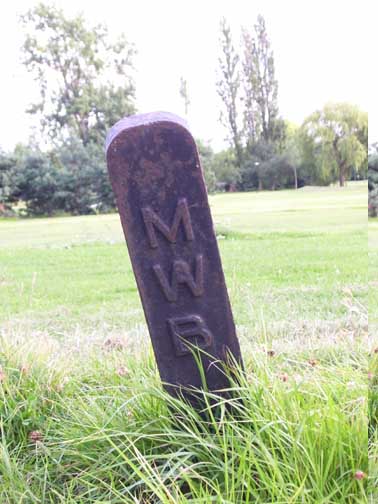 The old Metropolitan Water Board (now Thames Water) trunk-main leaves the London Borough of Barnet at the A5 Cricklewood Broadway. It is traceable briefly, just prior to this, at the point where it emerges from beneath the St. Pancras railway, alongside the railway cottages on the eastern side of the A5.Instinct directs the follower to cross the main road and to proceed down the street opposite, Temple Road. Not only does the street follow more or less in the same direction we have been tracing in our researches so far, but It is also known that there is a large ornate Victorian pumping house at the road’s end, close by Gladstone Park. Yet the street reveals nothing of the watermain intimately conjoined with it. There are none of the familiar indicators, the mushroom-topped gateposts or steel plates with which we identify the presence of the conduit.
The old Metropolitan Water Board (now Thames Water) trunk-main leaves the London Borough of Barnet at the A5 Cricklewood Broadway. It is traceable briefly, just prior to this, at the point where it emerges from beneath the St. Pancras railway, alongside the railway cottages on the eastern side of the A5.Instinct directs the follower to cross the main road and to proceed down the street opposite, Temple Road. Not only does the street follow more or less in the same direction we have been tracing in our researches so far, but It is also known that there is a large ornate Victorian pumping house at the road’s end, close by Gladstone Park. Yet the street reveals nothing of the watermain intimately conjoined with it. There are none of the familiar indicators, the mushroom-topped gateposts or steel plates with which we identify the presence of the conduit.
That is all changed at the end of the road, hard alongside a church with the chimney of the pumping house towering beyond. Here, where Mora Road “T”’s our first street a small length of channelling appears, running through to St Michael’s Road and towards the Thames Water Board’s station. It then runs across the park; a little fenced-in zone adjacent to the railway line that crosses through the park reveals the now familiar Blakeborough irons.
Crossing the bridge over the railway at the park’s south-western corner we enter Mulgrave Road and here, on the right, we see further evidence of the main in an elongated green-space and familiar green railings. This corridor is extended over on the far side of Dudden Road as the main begins to align with the approaching A406.
It is worth a pause here to contemplate the power and reach of this hidden and possibly imagined thing we have attached ourselves to: Starting at Golders Green, we have shifted down off of the gravels and sands of the Hampstead massif into the ditch of the A5 with its impertinent swamp dwellers. This is not so odd – I’ve many-a -time made that little shift myself, in order to secure stocks of cheap foodstuffs or medicine. Next, we passed through Gladstone Park: again, a person living in Golders Green might recourse to a visit to the park to walk the dog or to admire the view of the North Downs available from the old Post Office Telephone Research Station. Most people would drive nowadays, or bicycle, their arses sticking up in defiance as they pass into the cyclists version of interstellar overdrive in order to beat the traffic lurching forwards after being detained a whole fifteen seconds at a traffic light. However some oddballs may still choose to walk. Now, as we approach the moiling traffic of the North Circular we are on the cusp of a new zone - the land beyond the land beyond the land beyond our own zone. And it has been travelled to on foot for reasons beyond the understanding of the average modern town-dweller. I think you will agree that something strange is happening here.
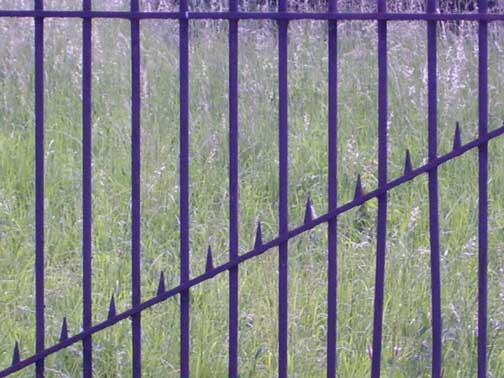
We search hard for indicators of the watermain
As we hit the A406 with its curious tilted camber and its obsolescent food-processing factories, its duck-weed infested feeder, serving the canal, and its supermarkets and furniture warehouses we are moving into hyper-space, readying ourselves for the red-shift to unimagined regions. And through it all, revealing its artefacts, like some long-dead ancient civilisation, runs the force, the tapped medium of Life Itself: Water.
Metropolitan Waterboard water to be exact. Pumped from the Lea, from the Thames at Ditton, up and over the Northern Heights (in either direction) and stored in vast concrete vats at Muswell Hill, West Hampstead, Horsenden Hill, Harrow and many other places. Pumped by electricity and stored so gravity can do the work for us, bringing this substance to our taps with sufficient pressure.
Actually the watermain runs slightly to the south of the A406. It passes under the horseshoe of Great Central Way and beneath Brentfield Road, crossing this to align itself with Meadow Garth and Conduit Way. As the great arch of the Wembley Stadium attempts to draw the eyes up, over the roofs of the houses to the vista beyond we scrutinise the dog-paraded street, looking for signs…
But we do not find them until, crossing Durand Way we enter the forecourt of those dingy office blocks. Here, on a sultry day in July 2005, we were lucky enough to find works in progress. A security man, initially suspicious, warmed to my heart-felt entreaties and showed us the diggings. It was a verification of everything I had supposed for, listening we could here water flowing and removing a piece of corrugated iron we saw the waters rushing below.
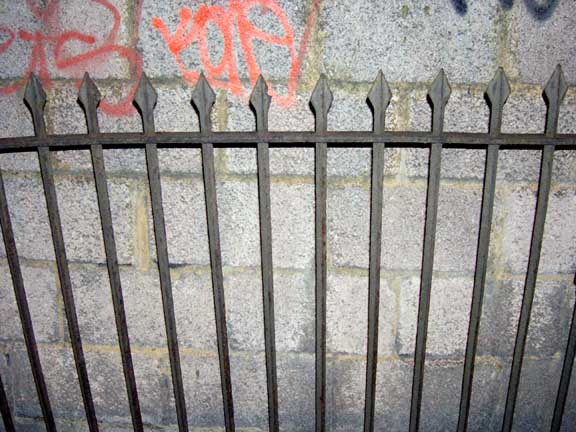
Those hastate palings are a sure sign we''re on the right track
The watermain crosses the A406 here, just by Stonebridge Park, with suggestions of its presence in hastate palings pressed hard up against brick walls on the bridge where the Euston railway is carried over the arterial road on its old arches. We are entering a region of unfamiliar quality. Across the North Circular is a vast man-made plateau holding a hypermarket of some kind. On the north side runs the Brent, and the old route of the A406. Further up is the Ace of Spades café, frequented by bikers and photographed with bewildering frequency by myopic psychogeographers. For myself, I’m onto larger things here so I walk up Beresford Avenue, a street containing classic examples of the “new smokeless manufactories of the South east.” I have projected the route of our watermain and am sure I will find its continuation ahead, somewhere to the left. Sure enough, a brief walk down Wycombe Road brings us to an angled crossing guarded by our friends, the mushroom-topped gateposts. It is our Way, presenting herself in all her glory.
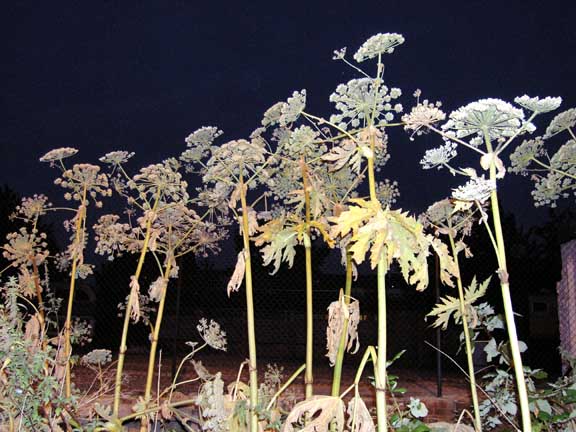
Giant Hogweed lines the watermain at Wycombe Close
Walking back the fifty feet along the designated route of the main we come to some of the giant plates that grant access for those individuals lucky enough to have privy to the Way’s deepest secrets. We can only stand and stare in mute admiration. John Rogers and Peter Knapp accompanied me on my last visit a couple of years back. We found a pile of discarded papers and books and, intent on adding documents to my Deep Library (a composite record of lives lived or endured in the old County of Middlesex) I set to, rummaging in the debris. John, the sod, found a fine 1960s map of New York. I picked out a 1967 Boots desk diary and a notebook of vicious rough-draft letters regarding the break-up of a marriage.
Sample:
I am told you want a devorce well that’s your problem. To much has been said about me how ar you frum your fhotograph you don’t look a day older what have you been takeing for god sake ansour my letter this time remember you are a Bascom and once that’s stoc on you you should never ever give it up
I read this, "stoc" in some dingy little industrial backstreet that night two years back and wondered at the world-lines all tangled, that should bring me and this Bascom together in the city’s awful complexity of lives and intersections. And drilling through it all, a persistent presence below the eras and ages, the haircuts and trousers (flared or drainpiped) and our silly obsessions and fashions, runs the Way.
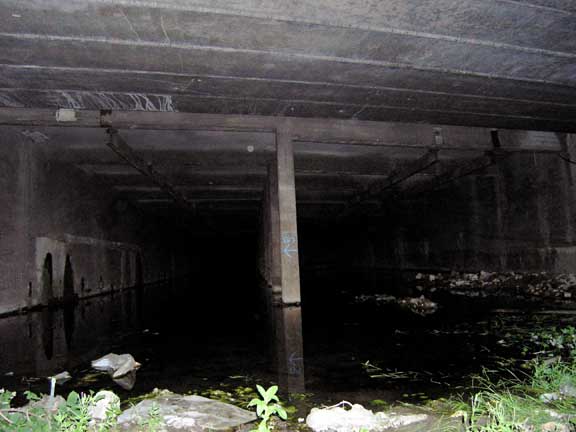
The black maw spoke of abrupt endings
Turning back we moved ahead to where the Way will pass beneath the canal. Our route was brought to an end at this stage by a cement building, a carpark or some such. This was really the End, for, looking into the open-fronted space forming the underbelly of the building we saw a vast lake stretching into darkness, a black sheet of water suggestive of arrivals at places long avoided; of abrupt terminations and the glugging maw waiting, all wet and patient, to reclaim us.
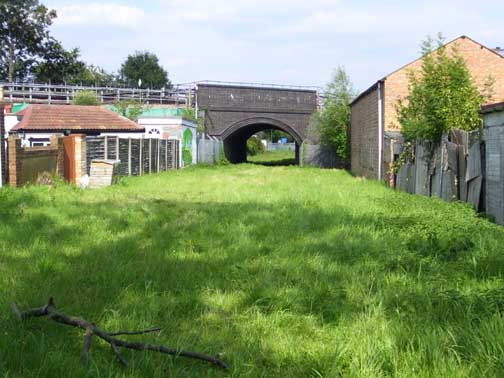
On towards Perivale...
We have hit up against a block. In the three or so miles covered since setting out from Golders Green we have passed through several clear and distinct zones.
First, we followed our water main down through suburban streets dating from the 1920s and 30s before crossing the busy A41(T) into more of the same. Next, after crossing the St. Pancras railway we have walked through an area featuring houses older than those north of the railway. We have visited a Victorian pumping house and cut diagonally across a park intersected by a railway line. For a while we walked through a residential area coloured by the Hindu temple on Conduit Road and overshadowed by the arch of Wembley. During this phase we were accompanied by the hum of the great arterial just over yonder, moving parallel with this. While willing to show interest in all this phantasmagoria we continued to bear in mind our primary purpose: These streets and parks were all just passing stages on our way; silly townships, snarling zip-cars and outposts of religion and sport. What has concerned us is something far deeper. For we have been tracing the residue of a race of giants, the trace of a great civilisation now passed. We have been following The Way.
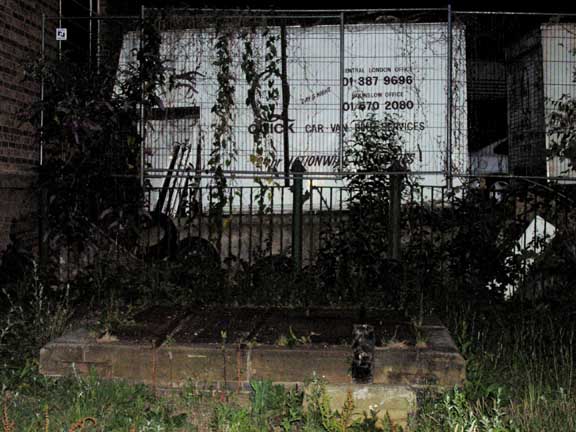
We bid farewell to Wycombe Road
(All pictures on this page (c) Peter Knapp)
We have familiarised ourselves with the indicators for The Way: octagonal gateposts with mushroom-like expansions at their top; hastate railings – often green – with spiked braces cutting diagonally across; small key-shaped markers poking out of soil and inscribed either with the letters MWB (Metropolitan Water Board) or the word “Track.” Then there are the crosshatched steel plates placed upon concrete bases and the odd tumulous-like mound, a campaniled pumping station and a mini-reservoir perched on a hillside overlooking Cricklewood.
Most of all though there has been the extensive but narrow vistas cutting dead straight through whatever has grown up alongside. Like some 17th century philosophical notion of substance, The Way has underpinned the shaping of the phenomena of the civitas. While unacknowledged, The Way has functioned as the tap-root nourishing our futile little lives; a pulsing generator of water existing prior to Heather Mills and Madonna, a God playing with rude toys fashioned of mud and straw.
Now we pass deeper and will bind the A41(T) to the A4(T), creating a conduit of topographic consciousness analogous to The Way itself, a consciousness connecting Golders Green tube station to one of Middlesex’s most iconic buildings.

A familiar sight presented itself
We leave Wycombe Road and work further along the A406, passing below the aqueduct carrying the canal over the road, and head towards Hanger Lane. A trading estate appears to our right and, knowingly now, we enter, expecting to find indications of The Way.
The Abbeydale Trading estate consists of a cluster of blocky brick units dating from around World War 2. Many of these are food processing plants serving the Indian restaurant trade. I like these estates as they serve to remind us of the underbelly of highstreet consumerism: There is a continual beeping and humming intentionality acting as a counterpoise to the momentary satisfactions of tikka or halva. The estate is named after Twyford Abbey, a large “cockney gothic” building across the North Circular, which will eventually be covered on this website.And here it is: cutting dead straight through gaps in the industrial units, sometimes grassed over, sometimes concrete covered, is the water main. A little brick utility hut breaks the otherwise barren course of the main, as it strikes southwest towards further lands and zones.
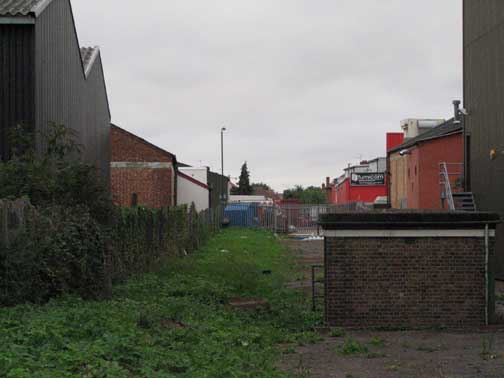
The watermain runs dead straight through the estate
London topographers refer knowingly to a series of aligned roads in Haringey as “the ladder.” 19 short streets ranging from Sydney Road in the north to Umfreville Road in the south form the rungs of this ladder. The rungs are supported by the tough parallels of Wightman Road and Green Lanes. Cutting centrally through all the rungs runs the New River, adding a further element of coherence to the architectonic of streets.
As we leave the Abbeydale trading estate and enter the Abbey (residential) estate we see a similar phenomenon. True, there are only 7 roads serving as rungs; and whilst the A406 serves as a serious analogue to Green Lanes or Wightman Road, the other support, Carylon Road falls a bit short of expectation, being a little old residential street rather than a main route. And whereas the Haringey Ladder has the New River cutting through the rungs and paralleling the support roads on either side, we find here our Way running through, further binding the coherence of the zone. I find the Abbey estate a sad place but am hard-put to say precisely why. An old gentlemen working his garden once told me a little Asian girl had been knocked over and killed just outside his house a few months prior to my visit but I don’t think it was this fact that induces the particular melancholy I feel when wondering about these streets. If there is a general air of futility about the place, the specific cues inducing it -toys lying forlornly in desperately tended gardens, TV screens glimpsed through windows, proudly polished automobiles parked half on pavements – are readily seen in numerous other locations.
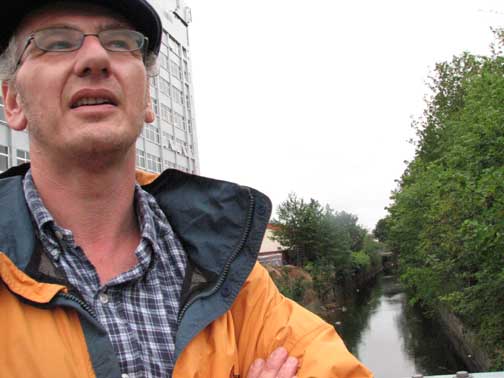
NickP surveys the waterways, July 2006
Even The Way seems to be affected, cutting straight through the monkey house to get clean away as soon as possible; bypassing the slightly down-market suburban house as if sickened by all the chat, all the crap quizzes and biro-scratched lottery forms of life here.I lose The Way beyond the estate though deduction leads me to assume it passes somewhere behind the furniture warehouses with their modern bas-reliefs illustrating leather sofas framed by classical pillars, modelled in moulded plastic or fibre glass.It is after the madness, the beautiful power, of the Hanger Lane Gyratory System that we locate The Way once more, and here the indications will be increasingly strong and pure.
We proceed up Hanger Road beyond the point where the River Brent passes beneath at Vicars Bridge. It is a short walk up Alperton Lane on the left to a sports field, one-time site of the sewage works serving the area before disposal was plugged into the West Middlesex Main Drainage Scheme (about 1935). This place was once the home of the “Wembley Pudding”, processed sludge cakes used for farming and gardening. A Mr Chapman, who managed the farm, grew peppermint on the sludge and so effective was the result the place became known as Peppermint Farm, oil produced here being sold in chemists throughout the region.
The south edge of the sports field is flat and straight-edged and ends in what could be a pumping shed or a World War II bomb shelter – it is a little difficult to decide which.
It is across the next street we come to, Manor Farm Road, that we once again enter the clear presence of The Way. Stretching ahead, a green lane running counter to our sultry afternoon concerns, The Way strikes out towards and beyond the viaduct carrying the electric tube railway between Hanger Lane and Perivale stations. It is eerie, this presence regained, a spirit-familiar doing its job continually throughout our varying stop-offs and sojourns en route. Several times in the next few hundred yards we have the opportunity to gaze along The Way, seeing it from different angles and directions at Lily and May Gardens.
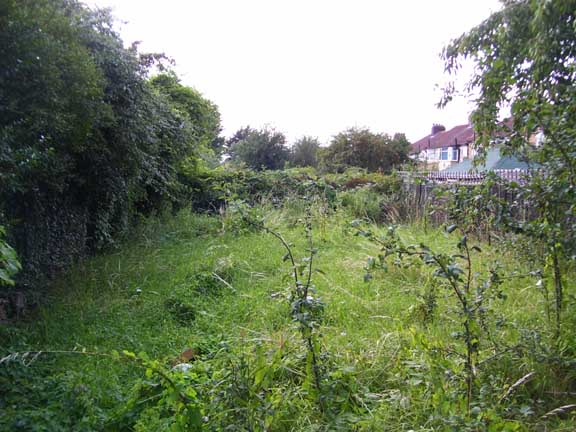 As the thrum of Western Avenue grows in our ears and we begin to fall within the gravitational force field of the Borough of Ealing we see The Way disappear below the edge of a small hill, the spine of which is formed by Rydal Crescent. The water main falls here into perfect alignment with Western Avenue and is picked up again by ascending Rydal Crescent and approaching the A4(T) via Hirlmere Avenue.The rush of traffic forms a crazed backdrop to The Way at the bottom of the road. To right and left the main carries on, bounded by designated grass lands and spied upon by the tops of semi-detached homes. We turn right, and follow through, along the arterial road, unsure here whether The Way has persisted in its general south-westerly route, carrying it across to the A4’s far side, or if it has shifted its axis slightly to parallel the west-north-west of the road. Luckily our green spaces show themselves clearly over the next two hundred yards or so, following the A4 on its north side towards the gigantic Hoover Factory, now a rather grand branch of Tescos. And this is where, once again, I am staggered.
As the thrum of Western Avenue grows in our ears and we begin to fall within the gravitational force field of the Borough of Ealing we see The Way disappear below the edge of a small hill, the spine of which is formed by Rydal Crescent. The water main falls here into perfect alignment with Western Avenue and is picked up again by ascending Rydal Crescent and approaching the A4(T) via Hirlmere Avenue.The rush of traffic forms a crazed backdrop to The Way at the bottom of the road. To right and left the main carries on, bounded by designated grass lands and spied upon by the tops of semi-detached homes. We turn right, and follow through, along the arterial road, unsure here whether The Way has persisted in its general south-westerly route, carrying it across to the A4’s far side, or if it has shifted its axis slightly to parallel the west-north-west of the road. Luckily our green spaces show themselves clearly over the next two hundred yards or so, following the A4 on its north side towards the gigantic Hoover Factory, now a rather grand branch of Tescos. And this is where, once again, I am staggered.
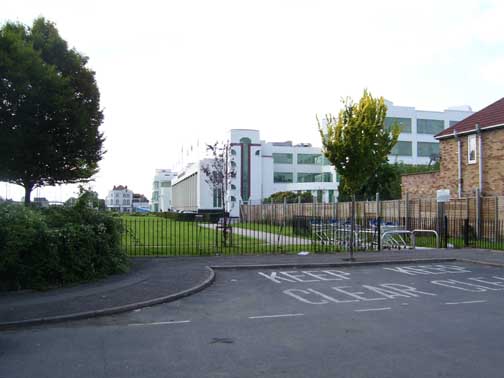
The water main runs across the front of the Hoover Factory
Here is this majestic art-deco factory, a long-favourite of architects and London Topographers. I have passed it many times, on foot or in a friend’s car. It is a singular entity and an integral factor in the region’s landscape. Etc. yet I never suspected when I set out, sensing as I did that my route would bring me close to the place, that the Hoover building was so integral. Slicing clearly across the large grass area at the front of the factory building runs The Way, bounded by and, itself, integral to the structuring of this astonishing temple.
Discovering this I should’ve lain down and wept but, in fact, I entered the supermarket and bought a Mars Bar and a bottle of mineral water. It was the best I could manage by way of paying honour to The Way. To think! When we stood at that little pumping station opposite Golders Green station, when we trudged the straight track of the Vale, cut through parks and suburban streets following the signs, we were already linked intimately with such a far-flung legend as the Hoover Factory. As I walked on towards Horsendon Lane South, a renewed vigour coursing through my legs, I wondered where else The Way would lead me before I finally reached the mystery of its far-distant terminus.
We know that the water main runs across the front of the Hoover Factory because we followed it there from Rydal Crescent. Now we are perched on the edge of new lands, new possibilities, but how to proceed? The Hoover Factory ends at a side street, Bedford Avenue, but where does the main go from here? Does it cross the A40? Or will it follow along our side of the road further west? We’ll have to trust the process and carry on along the main road, at least as far as the footbridge visible ahead because we cannot safely cross the streams of hurtling traffic before then.
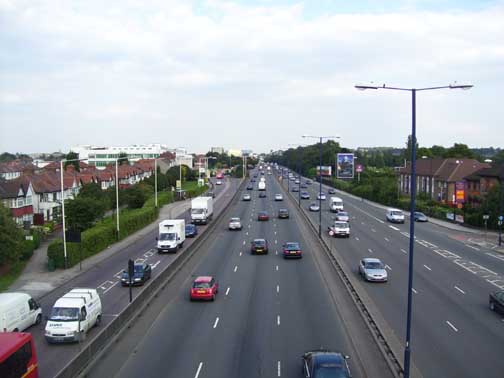
The A40(T) at Perivale: note the Hoover Factory and the hedged grass verge by Dawlish Avenue
This was the dilemma I faced when I reached this point recently (August 2007). Having made my mind up I proceeded along the A40 north-side, passing Dawlish Avenue, a line of semi-detached houses running alongside the A40 and separated from it by a thick verge of hedge-wrapped grass and ornamental trees. This looked promising; could the main be buried beneath the banal green utility? After crossing Horsenden Lane South, I saw an extensive sports field with a thin band of secondary woodland screening it from the traffic. I poked about in the thicket seeking signs: plates or irons; grates and markers; perhaps railings. I draw a blank and am on the horns of my dilemma once again: do I cross the A40 here to see if the Way has turned further south-west or do I proceed along the north side of the road as I have done for the last half-mile?
I thought about Dawlish Avenue with its verge, I contemplated the belt of woodland stretching ahead. I decided to carry on. As I got to halfway along the front of the sports field I spotted a small blue plaque marked “Water” and began to suspect I had made the right decision.
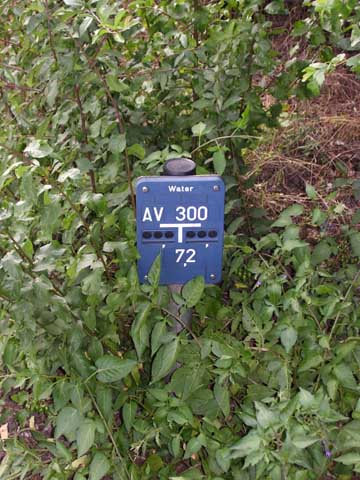
A small blue plaque gave me reason to hope
Next, opposite the junction between the A40 and Argyle Road I saw a stream tumbling down just inside the margin of the sports field and disappearing under the main road.
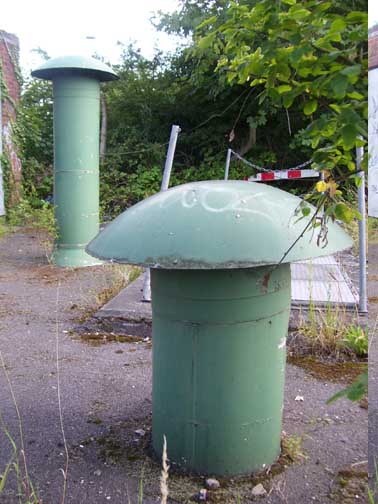
A pair of green mushrooms
presented themselves
This feature directed my glance across the A40 and there, in a little fenced-in pocket, I saw a likely pair of green mushrooms. Not gateposts this time, they are ventilators or some such for the main I suspect. I crossed as the traffic momentarily hushes for the Green Man, and approach the green structures standing quietly in their cage. I am on the right track once more.
I head south along Argyle Road, noting in passing that the streamlet has resurfaced, creating a beautiful mere, dense with purple loosestrife. To my right a short street, Stockdove Way, cuts through to where several successive segments of the Way are evident in a kind of receding striation. The general orientation is towards the railway bridge close by South Greenford station. I follow through now, mesmerised yet again by the sinewy reach of the Way, its no-nonsense determination to fulfil its function, creating the conditions required for our endless cycle of life and consumption. It is the autonomic nervous system of the city.

The Way points towards the railway bridge
Ahead, through the railway bridge is the large expanse of the Perivale golf course, stretching ahead to Greenford Magna. Just up, alongside the entrance to the golf course I spy metal plates, lichened slabs of concrete and, ahead, cutting across the course, a low causeway dotted with metal markers. I set off.
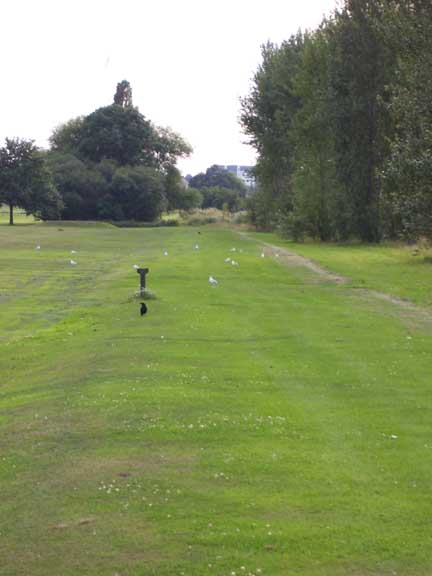
The Way stretched ahead towards Greenford Magna
In the long grass growing on the causeway are several MWB markers. I carry on until I hit a small stream, Coston’s Brook, carrying water from the area south of Sudbury Hill into the Brent. I think initially that it is the Brent and this throws me into a temporary aporia as I struggle with my Bartholemew''s Atlas of Greater London (1986 edition), which doesn’t include the stream in its detailing. However, I recall seeing the stream on a map included in Nicholas Barton’s The Lost Rivers of London and, reassured, cross by the footbridge. How the Way deals with the crossing of the stream I cannot say. It is either buried beneath the floor of Coston’s Brook or, perhaps, it is piped over in a tube mounted onto the infrastructure of the bridge. I tried to see if this was so but, due to dense vegetation, was unable to gain a suitable viewpoint.

A solitary octagonal gatepost
stood in my path
But cross it undoubtedly does. I walk a straight footpath heading towards Coston’s Lane and note that the Way is proceeding alongside me, heading towards a solitary octagonal gatepost, minus the railings usually attendant upon such a manifestation. Across Coston’s Lane the Way is visible, cutting ahead towards the Ruislip Road. Reaching this I see a Thames Water pumping house and feel assured I am doing things right.
But where do I head from here? I cannot see beyond the pumping house, embedded as it is in the floor of the valley formed by the River Brent. Will the Way follow strictly along the river south? Something compels me to walk to where Greenford Road runs south, perched a little up on the wall of the river valley, heading towards Uxbridge Road.
At first nothing shows. I traipse along Greeenford Road, passing a post office and a catholic school. Finally up ahead and on Greenford Road’s western side I see a derelict stonemason’s yard. I see gateposts and railings and I know my theory has been vindicated; It was the pumping station that gave it away – why would one be needed unless a rise, such as the one ahead at Dormer’s Wells, needed to be surmounted?
Looking diagonally ahead beyond the yard I see a stretch of the Way cutting from Windmill Lane to a road. After that there is a large public housing estate planted on the crest of the rise. Working through to this via King’s Avenue I deduce that the Way has been heavily disguised, crossing between two blocks in an area given over to swings and suchlike for the use of the local kids.
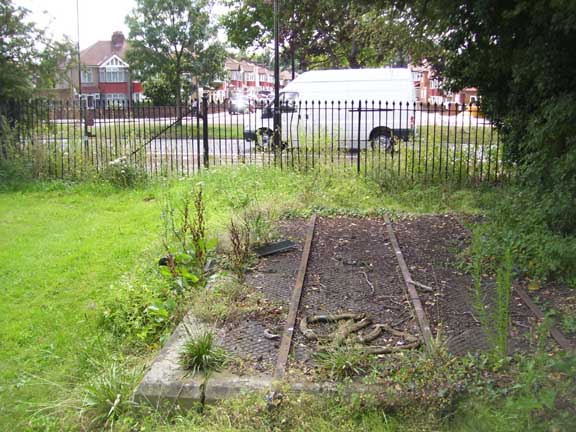
The view across Uxbridge Road from
the golf course
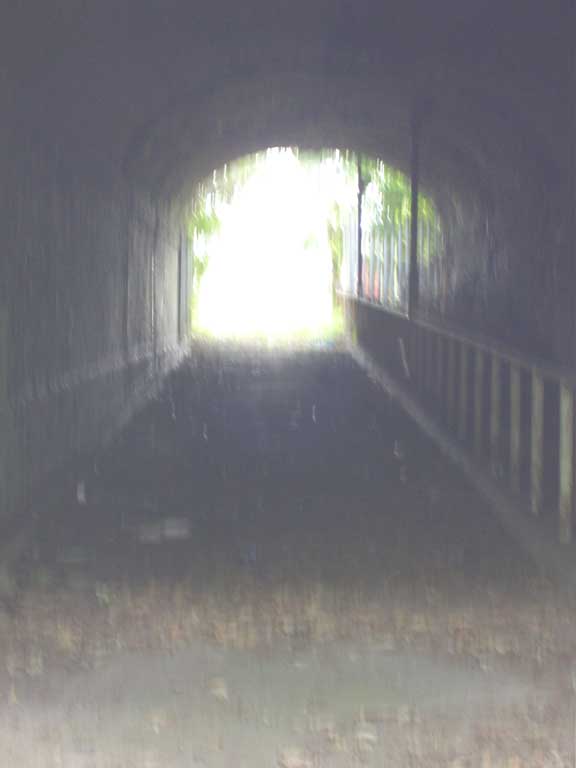
The water main forms the floor of the tunnel
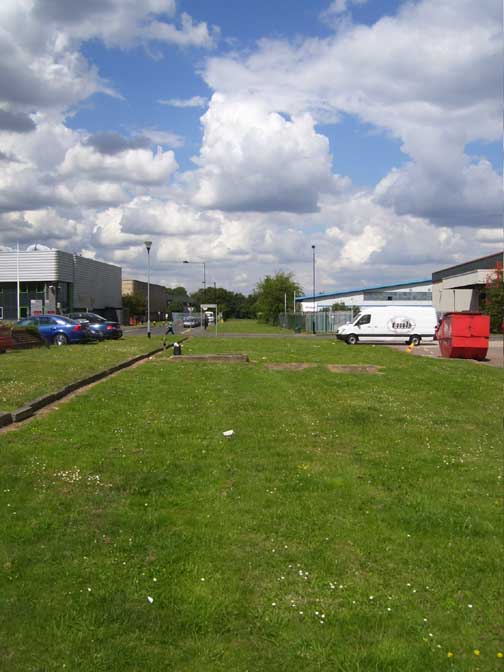
The Way cuts directly across the trading estate
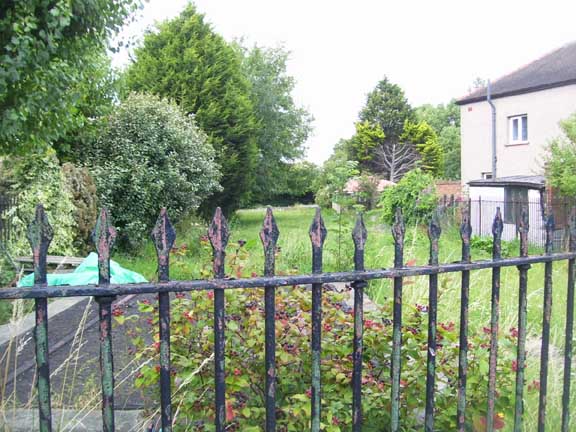
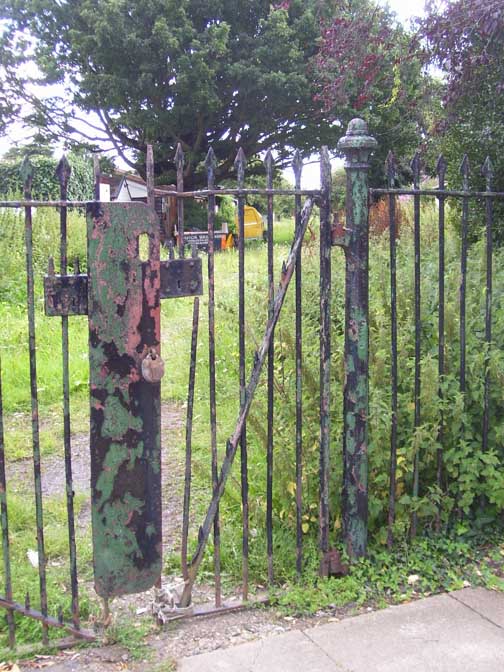
The view from Poplar Avenue looking north
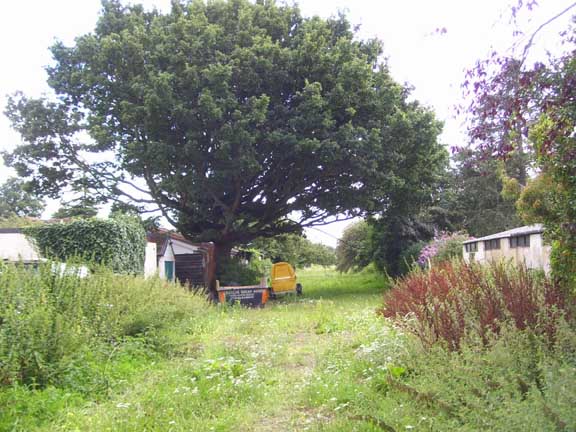
The view from Poplar Avenue looking south
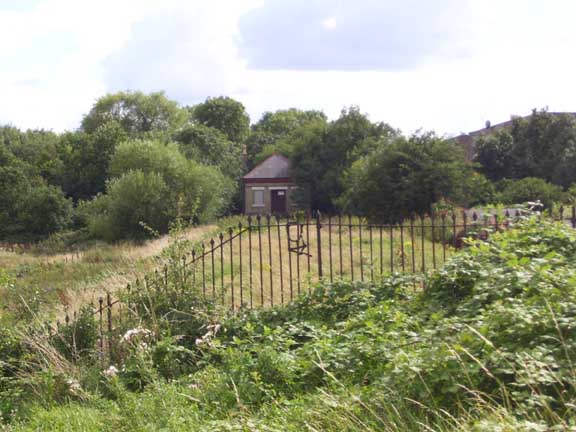
Singular beauty in Osterley Park
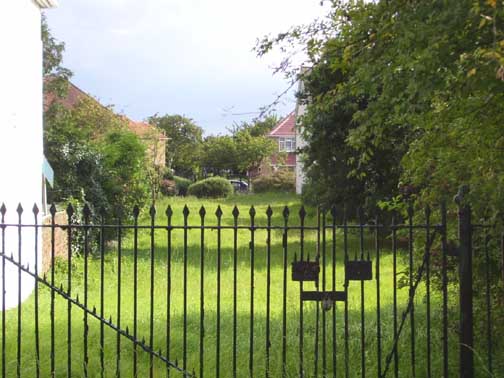
We approach Heston Road


